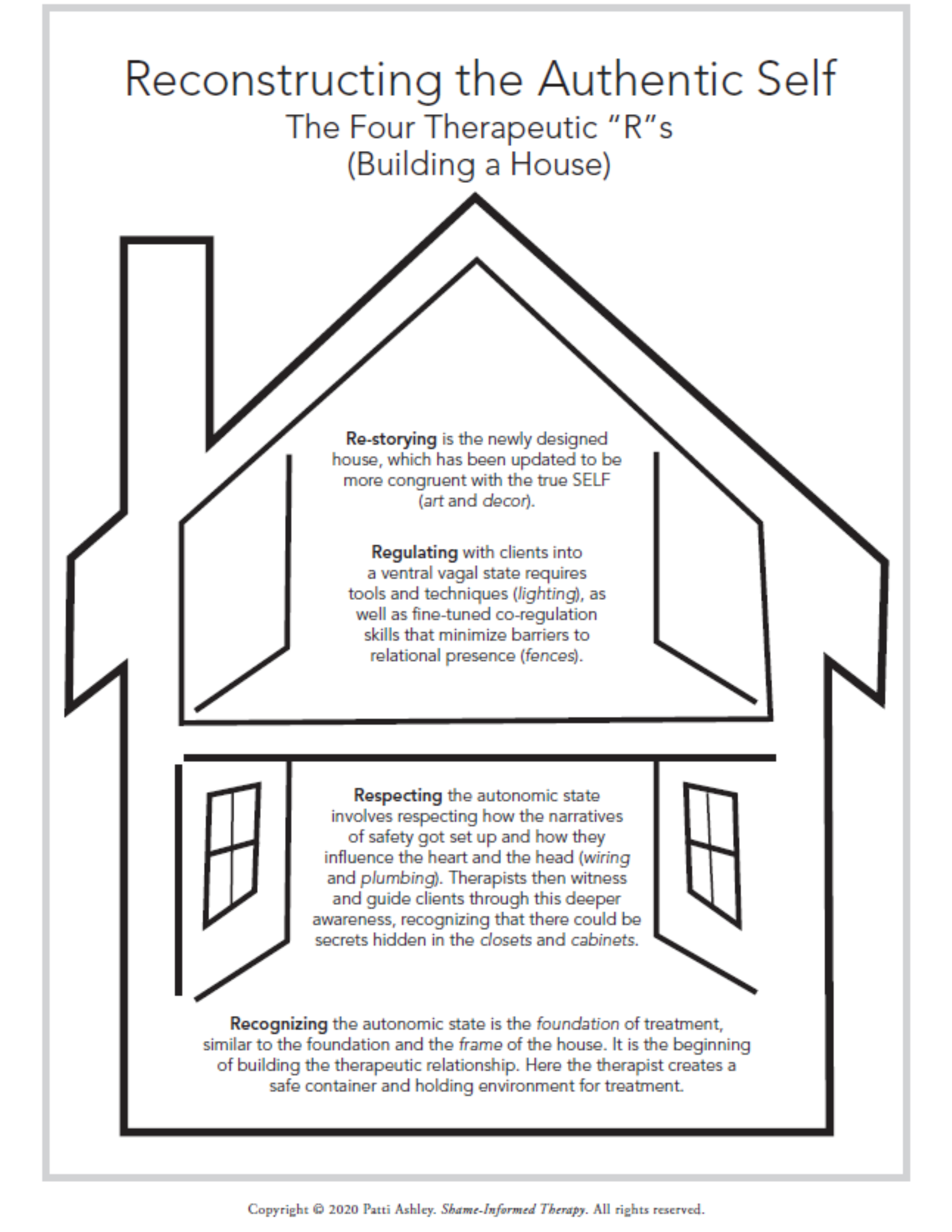The Four Therapeutic R’s
A Multimodal Approach for Treating Shame

In our therapeutic work as clinicians, we frequently see clients who come into therapy carrying with them a history of trauma and shame. To work most effectively with these clients, we must look through the lens of shame-informed therapy and follow the four therapeutic R’s: Recognizing the autonomic state the client is in, Respecting the adaptive survival response, Regulating or co-regulating with the client into a ventral vagal state, and then Re-storying.
The first therapeutic R is recognizing the autonomic state the client is in. The clinician is continually looking for clues regarding the client’s shame response. For example, if the client is in a dorsal vagal or freeze state, their shame response may involve silence, stiff or rigid affect, nonaction, apathy, and missed appointments. On the other hand, if the client is in a sympathetic or fight-or-flight state, their shame response might show up as anger, defensiveness, or arguing in session. Neither of these states allow for ease of connection or emotional co-regulation. The overall therapeutic goal is to co-regulate with the client into a ventral vagal state of safety and calm.
The second therapeutic R is respect. Clinicians must respect whatever state the client is in, holding an awareness that this adaptive state has historically served a purpose in the left-brain narrative of safety and survival. Respecting the state doesn’t mean it will be comfortable. For example, I was recently training clinicians about Porges’s four R’s, and a clinician questioned what it means to respect the dysregulated state. She described working with individuals in the criminal justice system who sometimes have no remorse and stated how it was difficult for her to respect that. I explained that respecting the state doesn’t mean we have to like it. It simply means respecting where the client is in the moment, knowing it is an adaptive response.
The third therapeutic R involves helping the client regulate into a ventral vagal state by promoting connection, social engagement, and safety. Doing so requires fine-tuned skills of empathy, compassion, and self-awareness. It involves being able to take perspective, avoid judgment, recognize emotion, and communicate this emotion to others (Wiseman, 1996). In this co-regulating therapeutic process, the therapist experiences four things all at once: (1) sharing the shame and humiliation of the client; (2) taking on their own perspective while regulating affect when feeling with the client; (3) bearing and containing the experience of being seen, even in instances of projection where the client views the clinician as the abuser; and (4) co-creating a new relational experience where both therapist and client collaborate and co-construct self-compassion (Knox, 2013.) Almost like a hologram, all aspects exist at once.
The fourth therapeutic R is re-storying. Here the clinician helps the client create a new narrative and provides somatic tools to embody this new story. In the re-storying process, the therapist and client begin to override the story that the client made up in the left brain early on by “editing and expanding the self-narrative of the left hemisphere to include the silent wisdom of the right” (Cozolino, 2002, p. 100). As the clinician and client write a new story—collectively as well as individually—they are working to strip away layers of old patterns, many of which live in the unconscious. Because core shame lives mainly in the implicit memory and autonomic nervous system, this process can feel like delving into an unexplored and rather mysterious realm, a type of twilight zone. The shame-informed therapist is brave enough to face the shadow material that emerges and co-create a new narrative different from any known before. Imagination is key. I always tell my clients this work is hard because what researchers have discovered about healthy self-esteem and family systems is not what prior generations have experienced; it is mostly unexplored territory.
So many factors affect the therapeutic work with clients that it can help to remember that healing takes time, very much like remodeling a historic house. Rebuilding an old house takes time and patience, and it may require being displaced to a rental home while construction is underway. It can also involve challenges in working with contractors and in deciding what updates to make and what fixtures to choose. Similarly, therapy requires that clients sort out what works and doesn’t work for them. It requires a commitment to the self over a period of time and the tenacity to stay with it. This process of rebuilding and remodeling is well illustrated in the following graphic, which I like to return to again and again to remind myself of the four therapeutic R’s.

*
This is an excerpt from Shame-Informed Therapy by Patti Ashley. Copyright ¬© 2020, Patti Ashley. ∞≈¿÷ ”∆µ Publishing & Media
The first therapeutic R is recognizing the autonomic state the client is in. The clinician is continually looking for clues regarding the client’s shame response. For example, if the client is in a dorsal vagal or freeze state, their shame response may involve silence, stiff or rigid affect, nonaction, apathy, and missed appointments. On the other hand, if the client is in a sympathetic or fight-or-flight state, their shame response might show up as anger, defensiveness, or arguing in session. Neither of these states allow for ease of connection or emotional co-regulation. The overall therapeutic goal is to co-regulate with the client into a ventral vagal state of safety and calm.
The second therapeutic R is respect. Clinicians must respect whatever state the client is in, holding an awareness that this adaptive state has historically served a purpose in the left-brain narrative of safety and survival. Respecting the state doesn’t mean it will be comfortable. For example, I was recently training clinicians about Porges’s four R’s, and a clinician questioned what it means to respect the dysregulated state. She described working with individuals in the criminal justice system who sometimes have no remorse and stated how it was difficult for her to respect that. I explained that respecting the state doesn’t mean we have to like it. It simply means respecting where the client is in the moment, knowing it is an adaptive response.
The third therapeutic R involves helping the client regulate into a ventral vagal state by promoting connection, social engagement, and safety. Doing so requires fine-tuned skills of empathy, compassion, and self-awareness. It involves being able to take perspective, avoid judgment, recognize emotion, and communicate this emotion to others (Wiseman, 1996). In this co-regulating therapeutic process, the therapist experiences four things all at once: (1) sharing the shame and humiliation of the client; (2) taking on their own perspective while regulating affect when feeling with the client; (3) bearing and containing the experience of being seen, even in instances of projection where the client views the clinician as the abuser; and (4) co-creating a new relational experience where both therapist and client collaborate and co-construct self-compassion (Knox, 2013.) Almost like a hologram, all aspects exist at once.
The fourth therapeutic R is re-storying. Here the clinician helps the client create a new narrative and provides somatic tools to embody this new story. In the re-storying process, the therapist and client begin to override the story that the client made up in the left brain early on by “editing and expanding the self-narrative of the left hemisphere to include the silent wisdom of the right” (Cozolino, 2002, p. 100). As the clinician and client write a new story—collectively as well as individually—they are working to strip away layers of old patterns, many of which live in the unconscious. Because core shame lives mainly in the implicit memory and autonomic nervous system, this process can feel like delving into an unexplored and rather mysterious realm, a type of twilight zone. The shame-informed therapist is brave enough to face the shadow material that emerges and co-create a new narrative different from any known before. Imagination is key. I always tell my clients this work is hard because what researchers have discovered about healthy self-esteem and family systems is not what prior generations have experienced; it is mostly unexplored territory.
So many factors affect the therapeutic work with clients that it can help to remember that healing takes time, very much like remodeling a historic house. Rebuilding an old house takes time and patience, and it may require being displaced to a rental home while construction is underway. It can also involve challenges in working with contractors and in deciding what updates to make and what fixtures to choose. Similarly, therapy requires that clients sort out what works and doesn’t work for them. It requires a commitment to the self over a period of time and the tenacity to stay with it. This process of rebuilding and remodeling is well illustrated in the following graphic, which I like to return to again and again to remind myself of the four therapeutic R’s.

*
This is an excerpt from Shame-Informed Therapy by Patti Ashley. Copyright ¬© 2020, Patti Ashley. ∞≈¿÷ ”∆µ Publishing & Media
You can find more information on shame-informed therapy, including how to integrate the four therapeutic R’s into your practice, in Shame-Informed Therapy: Treatment Strategies to Overcome Core Shame and Reconstruct the Authentic Self.

The tools in this book will allow you to work together with your clients to create and embody a new story of self-love and compassion—a story that is more congruent with their authentic self.



